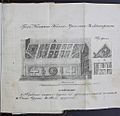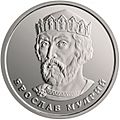Yaroslav the Wise facts for kids
Quick facts for kids Yaroslav the Wise |
|||||
|---|---|---|---|---|---|
| Grand Prince of Kiev and Novgorod | |||||
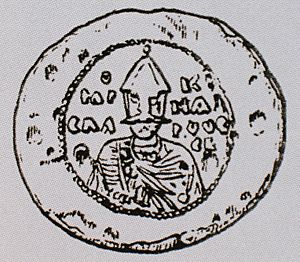
The only contemporary image of Yaroslav I the Wise, on his seal
|
|||||
| Grand Prince of Kiev | |||||
| Reign | 1019–1054 | ||||
| Predecessor | Sviatopolk the Accursed | ||||
| Successor | Iziaslav I | ||||
| Prince of Rostov (?) | |||||
| Reign | 978–1010 | ||||
| Prince of Novgorod | |||||
| Reign | 1010–1019 | ||||
| Born | c. 978 | ||||
| Died | 28 February 1054 (aged 75 or 76) Vyshhorod, Kievan Rus |
||||
| Burial | Saint Sophia's Cathedral, Kyiv | ||||
| Spouse | Ingegerd Olofsdotter of Sweden | ||||
| Issue Details... |
|
||||
|
|||||
| Dynasty | Rurikid | ||||
| Father | Vladimir the Great | ||||
| Mother | Anna Porphyrogenita | ||||
Yaroslav the Wise (born around 978, died February 20, 1054) was a powerful ruler of Kievan Rus'. He was the Grand Prince of Kiev from 1019 until his death. He also served as the Prince of Novgorod several times, bringing these important regions together. Yaroslav's Christian name was George, named after Saint George.
Contents
Becoming Grand Prince
Not much is known about Yaroslav's early life. He was one of the many sons of Vladimir the Great. It is believed he was the second son of Rogneda of Polotsk. However, his actual age suggests he might have been one of Vladimir's youngest children.
Some historians think he was born after Vladimir divorced Rogneda. Others suggest his mother was Anna Porphyrogenita. Yaroslav is known in Norse stories as Jarisleif the Lame. He likely had a limp from an arrow wound, which was confirmed by scientists who studied his remains.
When he was young, Yaroslav was sent to rule the northern lands around Rostov. In 1010, he moved to Veliky Novgorod, a very important city. While there, he founded the city of Yaroslavl on the Volga River. His relationship with his father, Vladimir, was difficult. It got worse when Vladimir decided to give the throne of Kiev to his younger son, Boris. In 1014, Yaroslav refused to pay tribute to Kiev. A war was only stopped by Vladimir's death in July 1015.
After his father's death, Yaroslav fought a long and difficult war for Kiev. He fought against his half-brother Sviatopolk I of Kiev, who had help from his father-in-law, Duke Bolesław I the Brave of Poland. During this struggle, several of Yaroslav's other brothers were killed. The Primary Chronicle blamed Sviatopolk for these deaths.
Yaroslav defeated Sviatopolk in their first battle in 1016. Sviatopolk then fled to Poland. In 1018, Sviatopolk returned with Polish troops and took Kiev, pushing Yaroslav back to Novgorod. But Yaroslav eventually won, and in 1019, he became the firm ruler of Kiev.
One of his first acts as Grand Prince was to give many freedoms and special rights to the people of Novgorod. They had helped him win the throne. This laid the groundwork for the Novgorod Republic. The people of Novgorod respected Yaroslav greatly. The princely home in their city was named Yaroslav's Court after him. During this time, Yaroslav likely created the first set of laws for the East Slavs, called the Russkaya Pravda.
Yaroslav's Rule
Family Challenges
Yaroslav is often called "the Wise" by historians. However, he did imprison his youngest brother, Sudislav, for life. Another brother, Mstislav of Chernigov, whose lands were far away, came to Kyiv. Even with help from his brother-in-law, King Anund Jacob of Sweden, Yaroslav lost a big battle to Mstislav in 1024.
After this, Yaroslav and Mstislav divided Kievan Rus' between them. Mstislav ruled the area west of the Dnieper River, with its capital at Chernihiv. He ruled there until his death in 1036.
Friends Along the Baltic Sea
Yaroslav made alliances with Scandinavian countries. He wanted to reduce the influence of the Byzantine Empire on Kiev. In 1030, he took the Cherven cities from the Poles. He then built Sutiejsk to protect these new lands. Yaroslav also made an alliance with Casimir I the Restorer, the King of Poland. This alliance was strengthened when Casimir married Yaroslav's sister, Maria.
In 1030, Yaroslav also captured Tartu, in Estonia. He renamed it Yuryev, after his patron saint, Yury. He made the surrounding area pay him yearly tribute. According to Heimskringla, a Norse saga, King Olof of Sweden made an alliance with Yaroslav to conquer Norway.
The Icelandic Sagas say that King Olof of Sweden married his daughter to Yaroslav. This caused protests in Sweden. The Swedes wanted to control their lost eastern lands and collect tribute from Kievan Rus'. But Olof chose to ally with Yaroslav the Wise.
Later in Yaroslav's rule, Ingvar the Far-Travelled led Swedish soldiers to help Yaroslav. They fought against the Pechenegs and Byzantines. Ingvar's fate is unknown, but only one ship returned to Sweden, according to legend.
Battle Against Byzantium
In 1043, Yaroslav challenged Constantinople again. One of his sons led a Rus' fleet near Constantinople. They demanded money and threatened to attack the city. The Greeks refused to pay and chose to fight. The Rus' fleet defeated the Byzantine navy. However, a storm almost destroyed the Rus' fleet, and they returned to Kyiv without any money.
Protecting the Dnieper Region
To protect his state from the Pechenegs and other nomadic tribes from the south, Yaroslav built a line of forts. These included Yuriev, Bohuslav, Kaniv, Korsun, and Pereyaslavl. In 1036, he won a major victory over the Pechenegs. After this, the Pechenegs were no longer a threat to Kyiv.
To celebrate this victory, he supported the building of the Saint Sophia Cathedral in 1037. In the same year, the monasteries of Saint George and Saint Irene were built. They were named after Yaroslav and his wife's patron saints. Some famous monuments from his rule, like the Golden Gate of Kiev, were destroyed during the Mongol invasion of Rus'. However, they were later rebuilt.
Setting Up Laws
Yaroslav was a great supporter of learning and books. In 1051, he made a Slavic monk, Hilarion of Kiev, the head bishop of Kiev. This was a challenge to the Byzantine tradition of having Greek bishops. Hilarion's writings about Yaroslav and his father Vladimir are considered some of the first important works of Old East Slavic literature.
Family Life and Children
In 1019, Yaroslav married Ingegerd Olofsdotter, the daughter of the King of Sweden. He gave her Staraya Ladoga as a wedding gift.
A fresco in Saint Sophia's Cathedral in Kiev shows Yaroslav and his family. It includes Yaroslav, Irene (Ingegerd's name in Rus'), their four daughters, and six sons. Yaroslav arranged for at least three of his daughters to marry foreign princes who were living at his court:
- Elisiv of Kiev married Harald Harðráði, who became King of Norway.
- Anastasia of Kiev married the future Andrew I of Hungary.
- Anne of Kiev married Henry I of France. She even served as regent of France while their son was young. She was Yaroslav the Wise's favorite daughter.
- It is possible that Agatha, wife of Edward the Exile, who was from the royal family of England, was also his daughter. She was the mother of Edgar the Ætheling and Saint Margaret of Scotland.
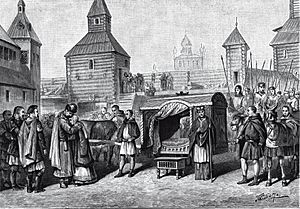
Yaroslav had one son from his first marriage, Ilya (who died around 1020). He had six sons from his second marriage. He wanted his sons to live peacefully together and warned them about the dangers of fighting. His eldest son, Vladimir of Novgorod, who built the Cathedral of St. Sophia, Novgorod, died before his father.
Three other sons—Iziaslav I, Sviatoslav II, and Vsevolod I—all ruled in Kyiv one after another. Yaroslav's youngest children were Igor Yaroslavich (1036–1060) of Volhynia and Vyacheslav Yaroslavich (1036–1057) of the Principality of Smolensk.
Yaroslav's Grave
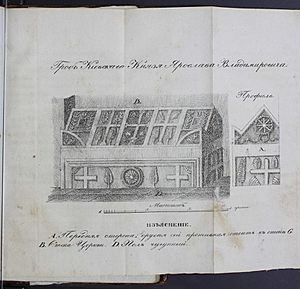
After his death, Yaroslav the Wise was buried in a white marble sarcophagus inside Saint Sophia's Cathedral. In 1936, the sarcophagus was opened. It contained the skeletons of two people, one male and one female. The male was identified as Yaroslav. The identity of the female was never confirmed.
The sarcophagus was opened again in 1939, and the remains were taken for study. They were not officially returned until 1964. However, when the sarcophagus was opened in 2009, it only contained one female skeleton. It seems the records from 1964 might have been wrong, and Yaroslav's remains were lost. Some believe his remains were hidden before the German occupation of Ukraine and then either lost or taken to the United States.
Yaroslav's Legacy
Four towns in different countries were named after Yaroslav. He founded three of them: Yaroslavl in Russia, Jarosław in Poland, and Yuryev (now Bila Tserkva, Ukraine). Another Yuryev (now Tartu) in Estonia was renamed after him between 1030 and 1061.
During the Crimean War, many Russian soldiers wore a helmet called the "Helmet of Yaroslav the Wise." It was the first pointed helmet used by a modern army.
In 2008, Yaroslav was voted the greatest Ukrainian in a TV show called Velyki Ukraintsi. He received 40% of the votes.
In 2003, a monument to Yaroslav the Wise was built in Kiev, Ukraine. The artists were Boris Krylov and Oles Sydoruk.
The 2010 movie Iron Lord was based on Yaroslav's early life as a regional prince.
Veneration
| Yaroslav the Wise | |
|---|---|
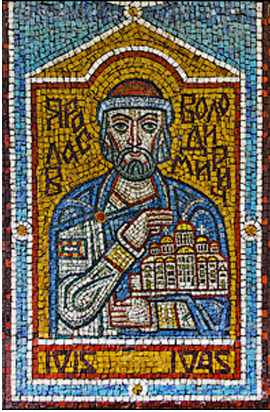
Yaroslav the Wise's consolidation of Kyiv and Novgorod as depicted at Zoloti Vorota mosaics
|
|
| Holy Grand Prince | |
| Honored in | Eastern Orthodox Church |
| Canonized | February 3, 2016, Moscow by Bishops' Council of the Russian Orthodox Church |
| Major shrine | Saint Sophia Cathedral, Kyiv |
| Feast | 20 February |
| Attributes | Grand Prince's robes, sword, church model, book or scroll |
| Patronage | Statesmen, Judges, Jurists, Prosecutors, Temple Builders, Librarians, Research, Scientists, Teacher, Students, Kievans |
Yaroslav was first called a saint by Adam of Bremen in 1075. However, he was not officially made a saint until much later. On March 9, 2004, on the 950th anniversary of his death, he was added to the calendar of saints by the Ukrainian Orthodox Church (Moscow Patriarchate). On February 3, 2016, the Russian Orthodox Church also allowed his worship throughout its churches.
Images for kids
-
Eleventh-century fresco of Saint Sophia's Cathedral, Kiev, representing the daughters of Yaroslav I, with Anne probably being the youngest. Other daughters were Anastasia, wife of Andrew I of Hungary; Elizabeth, wife of Harald Harðráði; and possibly Agatha, wife of Edward the Exile.
-
Sarcophagus of Yaroslav the Wise.
-
Coins of Yaroslav and his descendants represent the trident.
-
Yaroslav's monument in Yaroslavl as depicted on the ₽1000 banknote
-
The ₴2 banknote with a portrait of Yaroslav the Wise.
See also
 In Spanish: Yaroslav I el Sabio para niños
In Spanish: Yaroslav I el Sabio para niños






